by Luis Cotovio and Daniel George

Episode 4: Gravestone on a Frozen Field
(Japanese Name: 氷原の墓標 / Hyougen no Hakajirushi)
Director: Masato Bessho
Running time: 24m 41s (21m 01s without credits)
Opening Theme:
- (Cinema/Home Video): Uchuu Senkan Yamato by Isao Sasaki
- (TV): Uchuu Senkan Yamato by Project 2199
Ending Theme:
- (Cinema/Home Video): For Those Who Know the Beautiful Earth by Aki Misato
- (TV): Love Words by Mika Nakashima
[DG]: This episode starts on February 14, 2199 (363 days remain as per the preview for this episode).

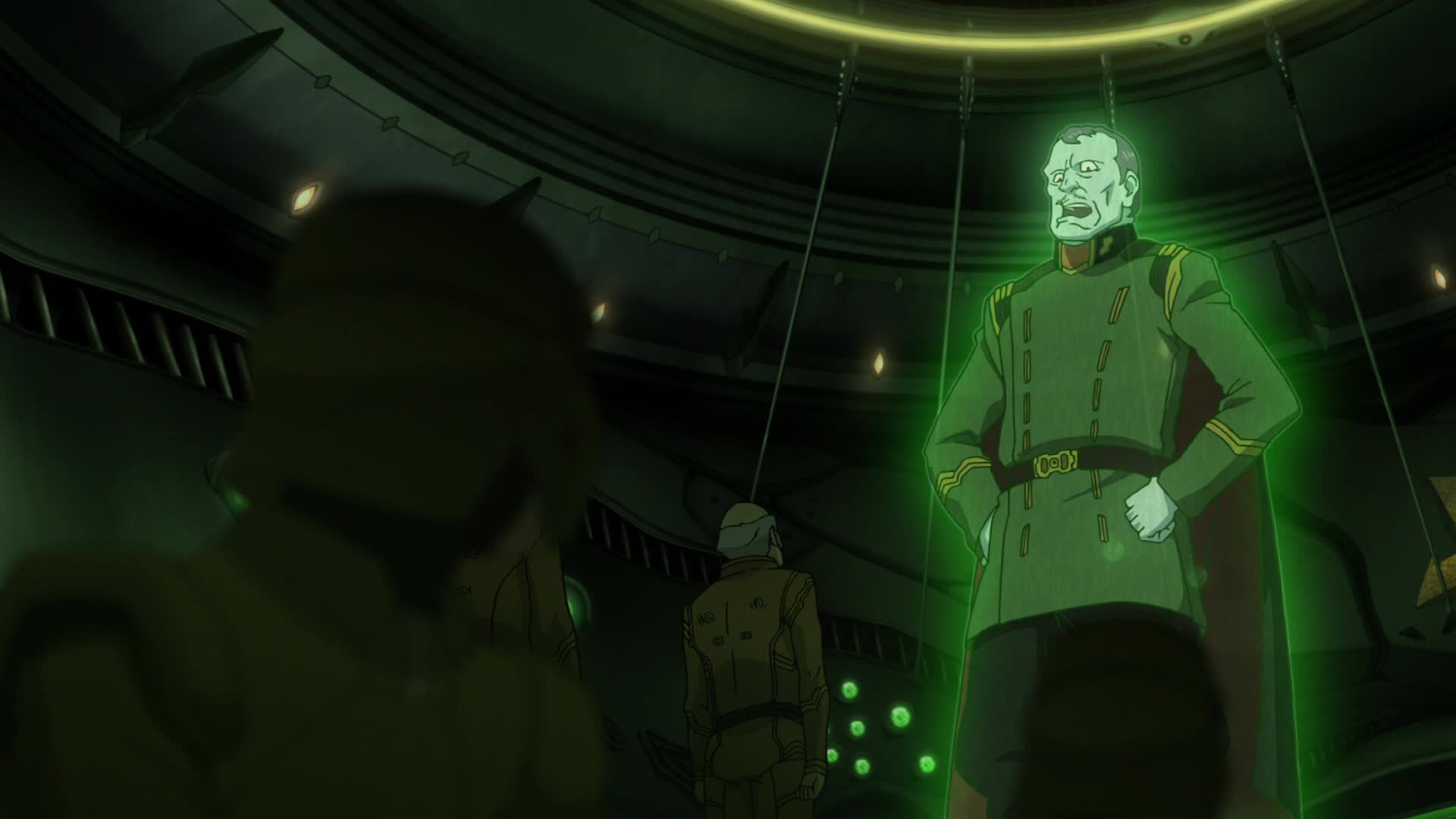
Garmillas Advanced Base on Pluto. Galactic theatre commander Gremdt Goer’s hologram towers over the officers in central command as he questions the accuracy of Shulz’s report, concerning the Terron ship and its apparent ability to not only perform faster-than-light travel but to also destroy the floating continent at Jupiter.
[LC]: After being mentioned in previous episodes, we finally get to see Goer. It’s clear right from the start that he’s the same sleazy bastard we know and love, with the difference that here he is the de facto commanding officer and his hubris is at an all time high as we see him at the top of his game. In the original series, he was only introduced as Domel took over his command at Balan.
Goer’s hologram towers over Shulz and his men so that he, as a pure blood first-class Garmillan, can look down on them as second-class citizens. This is a subtle but effective way of introducing the class system within the Garmillas Empire social structure. It’s also implied by Goer’s statement that if you prove yourself worthy to the empire you can become a first-class citizen.


[LC]: The comments made in previous episodes by Shulz and Ganz show that they consider him an opportunistic, less-than-capable, and unreliable commander. The fact that he dismisses Shulz’s report about the terrons newfound power, even in the face of overwhelming evidence, confirms this.
This plays right into the overall story arc, in that if a competent commander had been in charge at this time and proper weight given to the situation, Yamato might have found itself the target of a decisive attack and never have even left the solar system.
Shulz is no longer the over-confident buffoon of the original series and might have been capable of dealing with a single Terron ship, even one as powerful as Yamato, if given the means to fight it. But because Goer is unwilling to give credit to Shulz, the Pluto base commander is left to his own devices and forced to use the resources he has available. As we’ll see in the following episodes, they pose a challenge to Yamato but will prove insufficient.


Though Shulz tries to reason with him, Goer simply replies that he will only report to their leader when Shulz has provided a “proper” report; basically an order to solve the problem before any further reports are made. He also implies that if they do as they’re told, he’ll put in a good word with command to promote them all to first-class citizens, something that seems to please Ganz.
[LC]: Whether that was their intention or not, Goer ends up being one of the more expressive characters in 2199. Looking at his facial expressions and the way he’s animated throughout the series, I found myself making comparisons to hand-drawn Disney-style animation. I think Goer would fit right in as the villain in movies like Aladdin or Tarzan.
This also marks the first appearance of Major Vuol Yaretora, who is almost an original 2199 character but for the fact that Kodai fought a Gamilas soldier named Yaretara on Titan in the ’74 series. Yaretora is not only one of Shulz’s more trusted officers, he’s also in charge of Reflex Gun operations and the one who, according to his character file, drew up the Planet Bomb attack plan.


Though he complies with his commander’s order, as soon as the line is cut off Shulz shows concern over Goer’s inability to grasp the seriousness of the situation. Looking at the image of Jupiter’s scarred surface, he ponders what could have done such a thing.
[LC]: The damage we see on Jupiter’s surface seems to cover a bigger area than seen in the previous episode. This may be due to the bulk of the damage not being caused directly by the Wave-Motion Gun, but instead secondary effects like a displacement wave of the fluid atmosphere. Think of it like a super tsunami – several times the size of the Earth. Given that there’s no land mass in Jupiter, we can assume this wave will continue to spread out, perhaps spanning the entire planet, or until its energy somehow subsides.
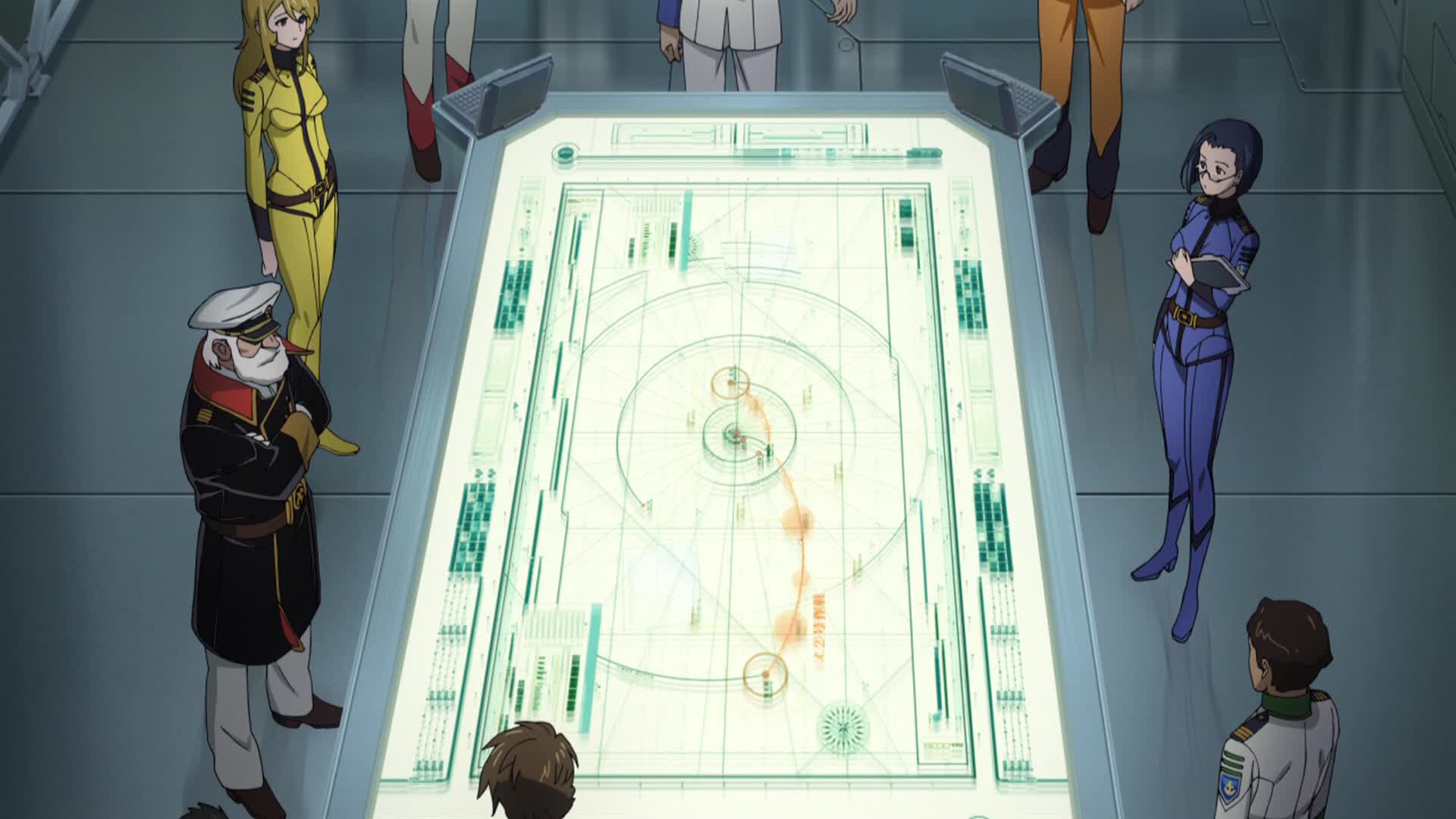
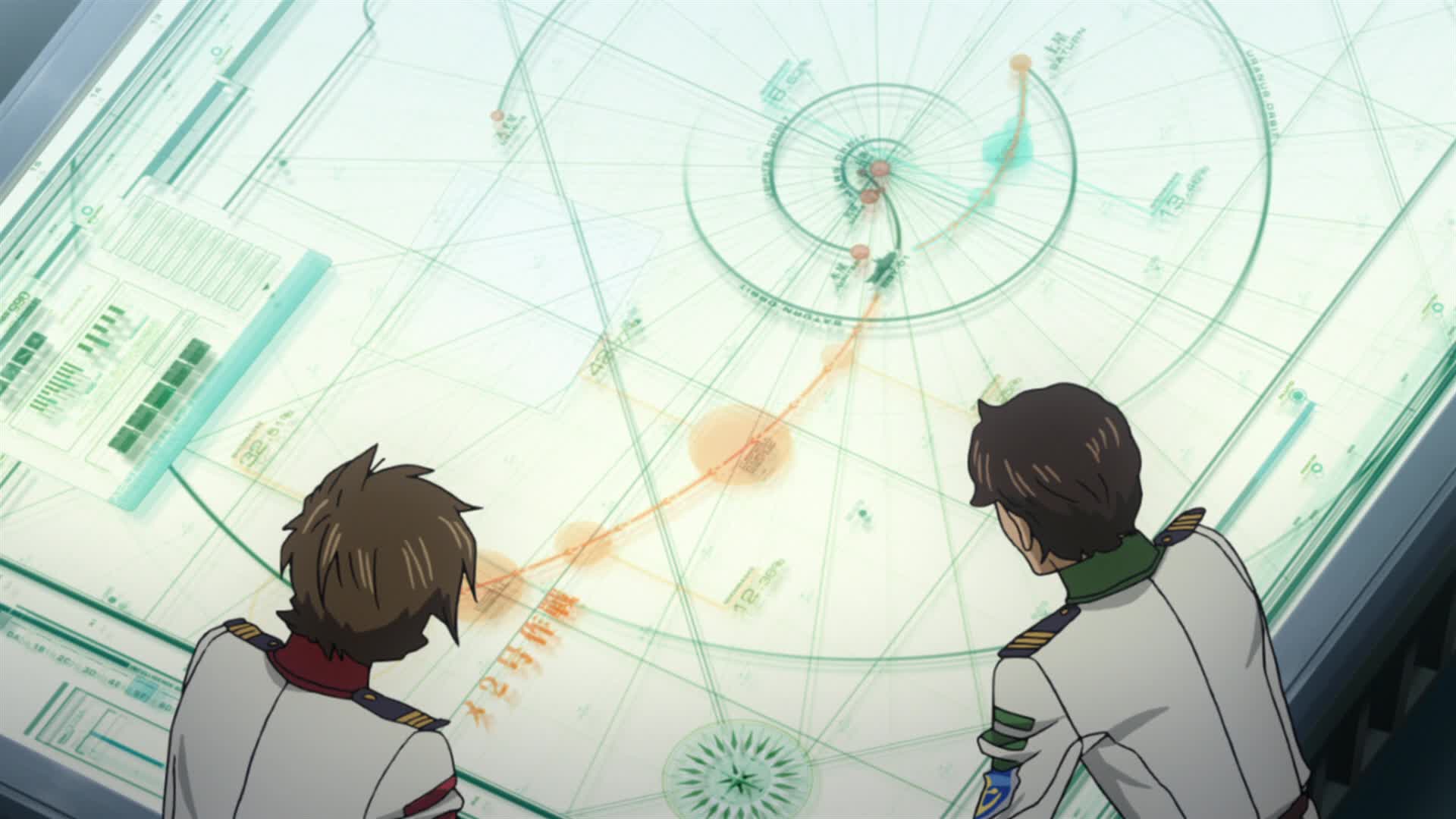
Yamato’s main staff is gathered in the navigation analysis room to discuss their next move, especially whether or not to carry out Operation M-2. Kodai states they should do it, if only to prevent further problems upon their return. When Okita asks Shima’s opinion, he displays the course that he believes will allow them the quickest way out of the solar system.
[DG]: This map is considerably different to the one that Hijikata, Toudo, Serizawa and Yuki were observing back in Episode 1 (seen here). If we look at a larger version of the map shown above right (click here), Earth has suddenly managed an entire quarter revolution in less than a week. It was at this point that I decided the production crew wasn’t aiming for any degree of accuracy with these maps, just for them to look cool and give a crisp, sleek feel to the technology aboard ship.
[LC]: Notice the map in the opening shot. The course Shima will describe as the fastest way out of the solar system is already on the screen (above left), even though Shima only puts it up later in the scene (above right).
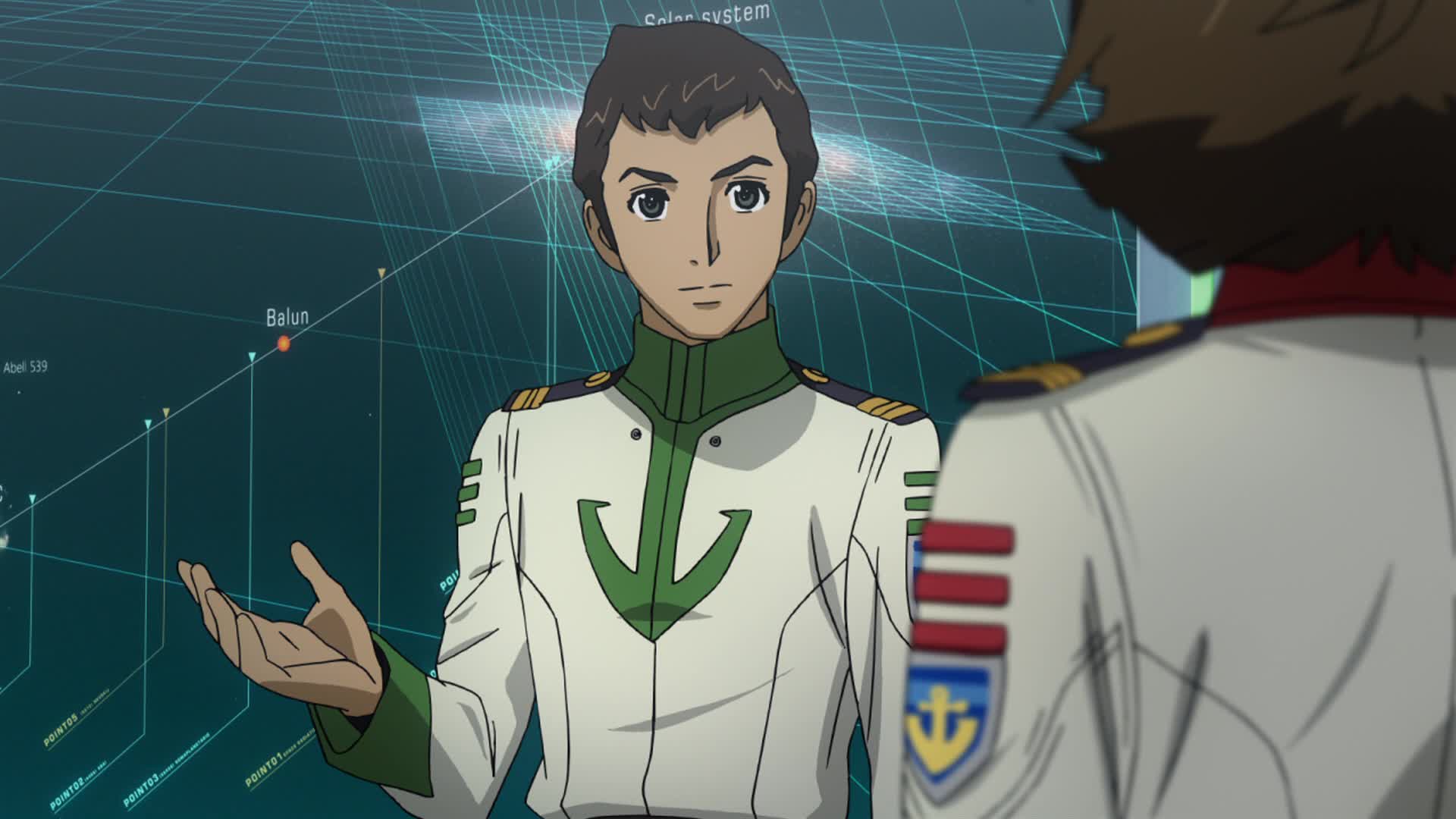
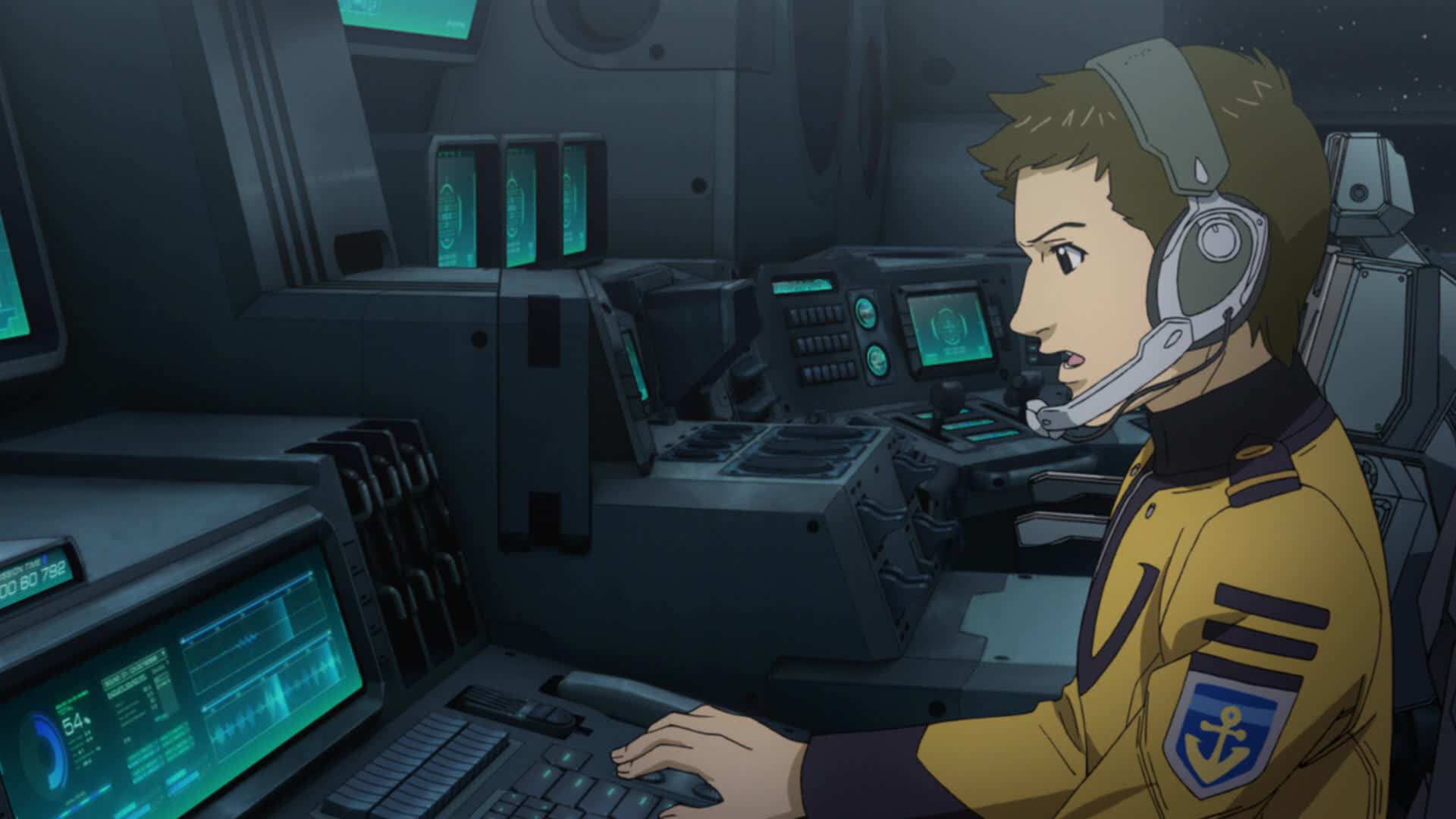
Kodai disagrees with this as it will make them “pass Pluto without mounting any attack” but Shima is adamant that their flight plan has no leeway to allow for a stop at Pluto. As Kodai prepares to counter, Aihara calls from the main bridge. A distress signal is coming through a dedicated UNCF channel. Though they can’t identify the ship, the signal is traced to Saturn’s moon Enceladus.
[LC]: If you look carefully at the map on the wall screen behind Shima (above left), you’ll notice a familiar name on the projected course to Iscandar. It was at this point that Planet Balan (original spelling) became Balun.
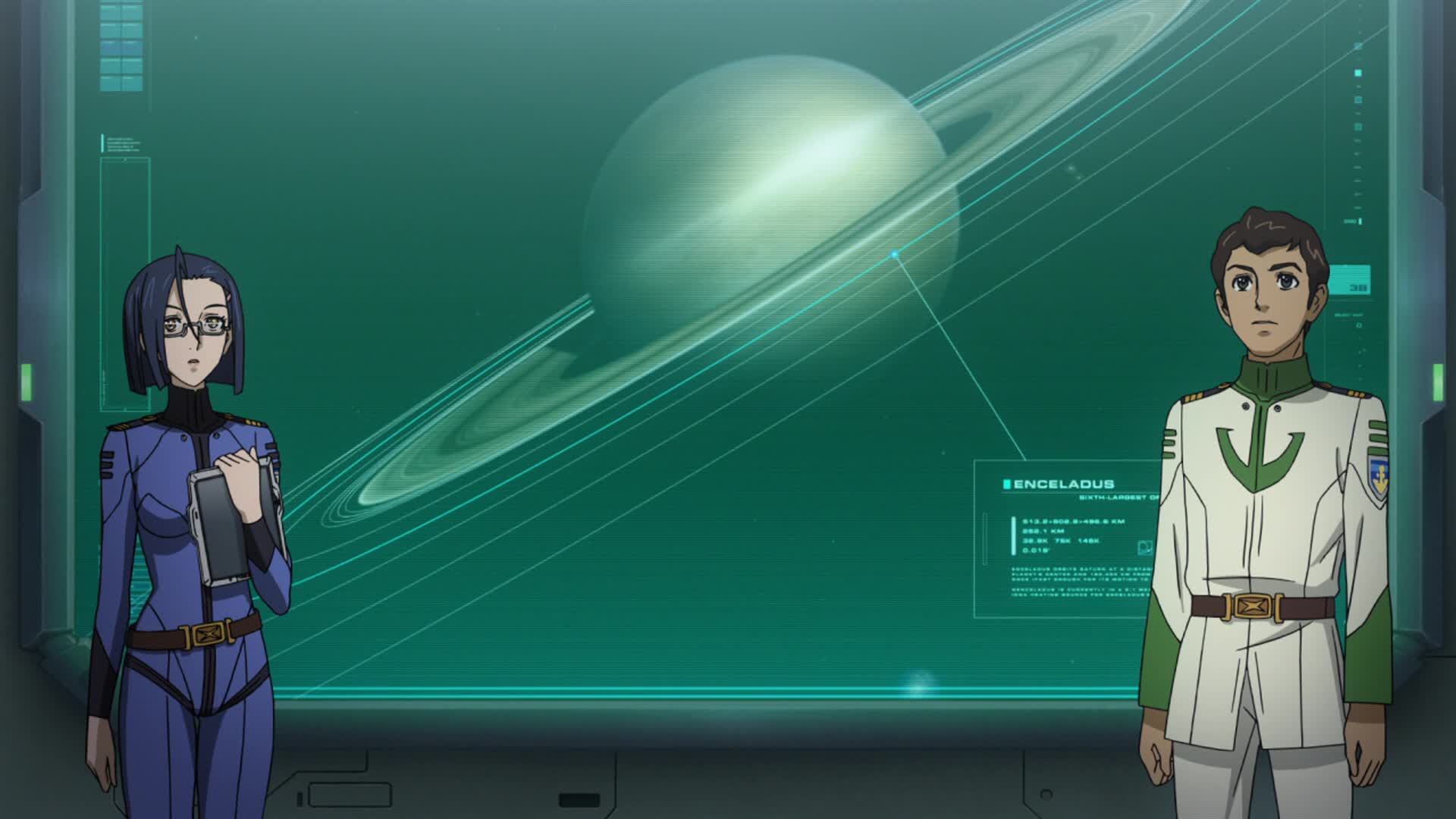

[LC]: There are oddities in the dialogues between Kodai, Shima and Ota in relation to what it shown on the graphic displays in these scenes. First it’s Kodai’s statement about “passing Pluto” when the display shows that Shima’s proposed heading takes Yamato in the opposite direction.
Now here, Ota correctly states that Saturn is in the opposite direction of Pluto but Kodai then replies that it’s also in the opposite direction from the course Shima and Ota have plotted. Again, Kodai’s line contradicts what is shown on the graphics, where Shima’s projected course did move away from Pluto to head in Saturn’s direction.
But even this is somewhat of a weird choice too, as from the planets’ positions on the map, it will make them turn nearly 180 degrees from the direction they’ve been following since they left Earth. We can assume this would be the direction they’d follow all the way to Uranus if their warp test had been successfully completed. Of course, it should also be noted that on this map Uranus can be seen on the far left, nowhere near their current heading. (Oh, boy!)
These contradiction can be explained in two ways. The first is a practical, real world explanation: communication between the script and effects departments of 2199’s production broke down somewhere, resulting in these disparities between what the characters say and what the visuals show.
The second is an in-story explanation. Given the dialogue contradictions stem mostly from Kodai’s lines, we can just assume he can’t read a map. And Shima doesn’t really know where he’s going.


Sanada tells Okita that diverting to Enceladus to mount a rescue will cost them two days. Kodai states that they shouldn’t lose any time there. Shima argues that a sailor never abandons another sailor in distress, but Kodai counters that since they’re unsure there are any survivors, a rescue operation is a waste of time – the very waste Shima wanted to avoid before. Shima defends their priority is to reach Iscandar, not battle the enemy, but a rescue must be attempted no matter how slim the chances.


The meeting is cut short as the ship rattles, knocking everyone off their feet. Tokugawa reports that a failure in a circuit breaker during the Wave-Motion Gun’s firing caused one of the energy condensers to overheat to the point of literally melting.
[LC]: You’ll notice that though everyone in shot has lost their footing, Sanada remains unshaken and so cool-headed that he’s holding the phone before Yuki’s butt even touches the ground. Early speculation was that his bionic legs (as seen in the original series) locked him to the floor, but it was later learned that the issue of his mechanical limbs never came up in the writing of 2199. Thus, he’s simply…different.


To repair the engine, they need a rare mineral called Cosmonite 90. The quantities they have on board are insufficient, but Niimi finds an abandoned cosmonite mine on Enceladus. With no other options, Yamato heads for Saturn.
[DG]: Shima is quite clearly taking this situation more personally than he should. We learn why later in the episode. Had the diversion to Enceladus not been dictated by the need for Cosmonite 90, one would assume that Okita would disregard the distress signal. After all, we’re talking about the future of all humanity versus the crew of a single ship who can’t even be confirmed as alive at this point.
[LC]: This episode reveals a lot more of the Garmillan base on Pluto, which had only been seen briefly in episode 3 during the IPBM launch scene. A better look at that same section is seen at the start of the episode but this is where the magic truly happens, the command center which is actually on the rim of the frozen crater where the Reflexion Cannon is, while the bulk of the base is behind it in an adjacent crater. The Pluto base, much like most of the Garmillan sets, was designed by Makoto Kobayashi. (click on the image above right for larger views)
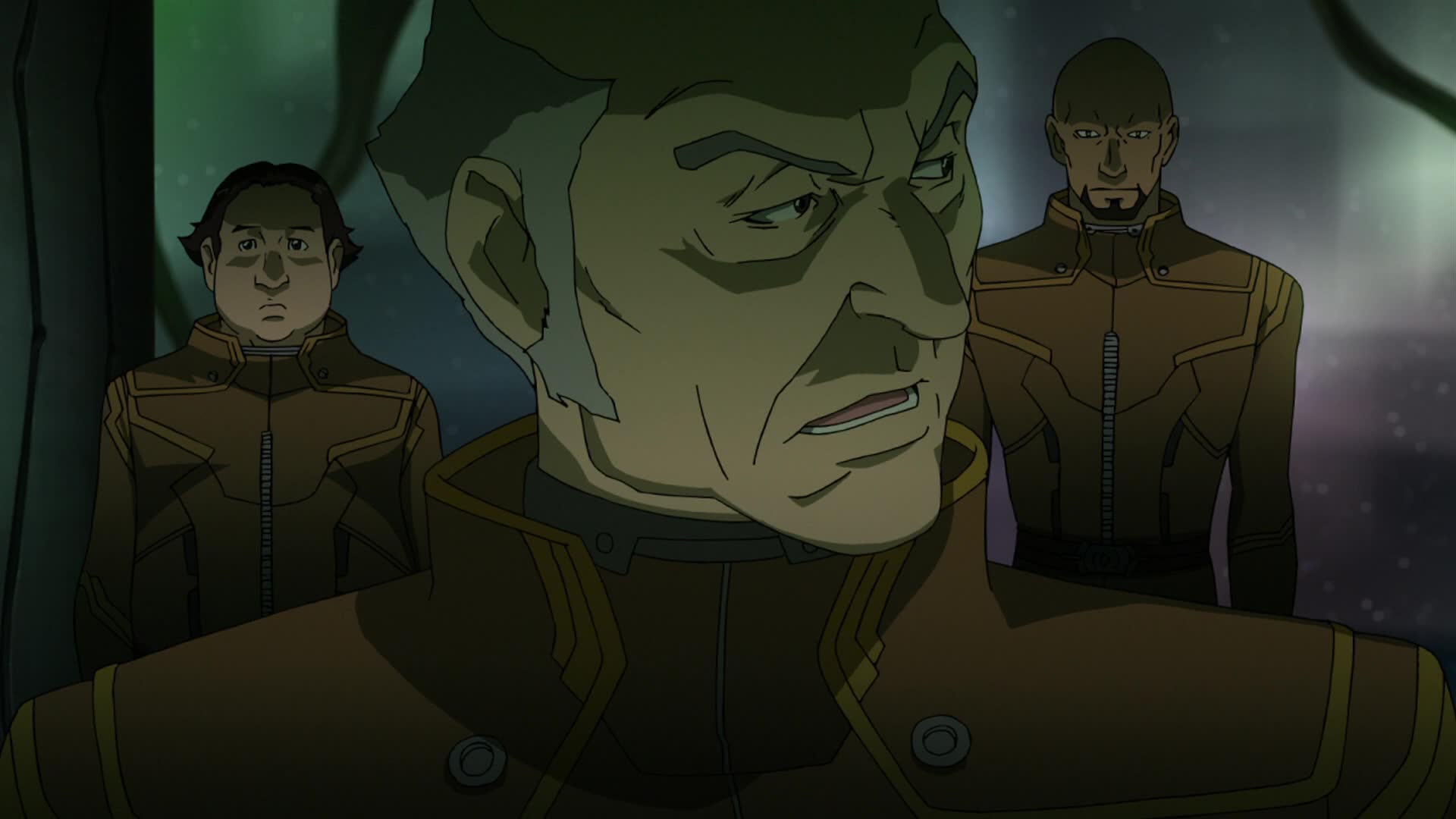

Shulz is informed that the Terron ship has changed course and its heading for Saturn. He orders Yaretora to deploy a recon landing ship they have in the area, and to take prisoners if possible. He wants to know what the Terrons are up to.
[LC]: Much like Jupiter/Zupist, Saturn has its own Garmillan name, Zedan.
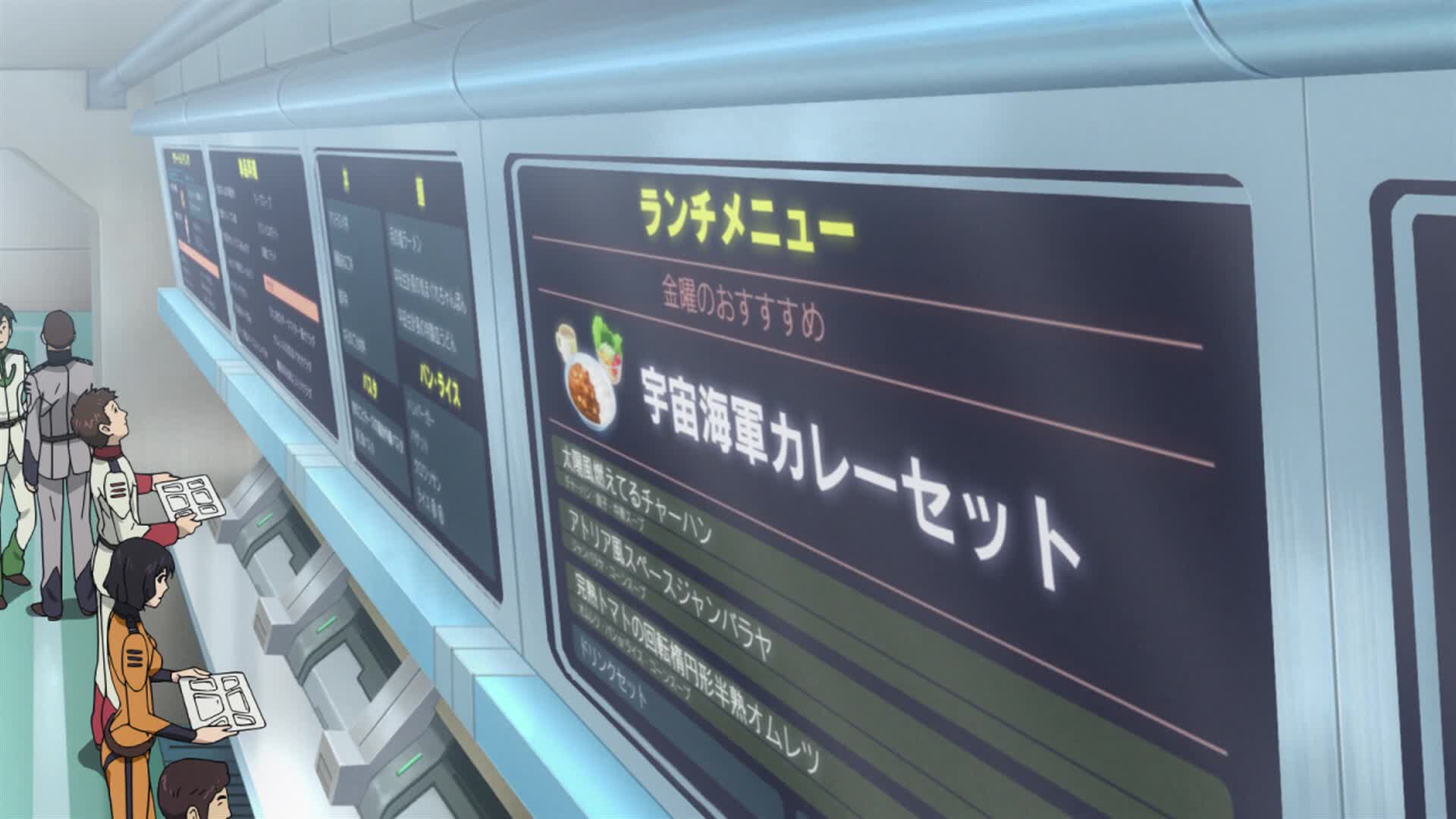

In Yamato’s mess hall, Aihara and Ota are talking about the wonder that is the O.M.C.S. when they see Sanada at a table, reading. Ota is baffled at his meal, consisting of simple nutrient and supplement bars.
[LC]: Here we see the previously mentioned O.M.C.S. or at least the part where food is dispensed in Yamato’s mess hall. The acronym O.M.C.S. stands for Organic Material Cycle System and, as Sanada tells Aihara, better not know the process behind it (though we can imagine).
For those wondering, yes, the O.M.C.S. is based on Star Trek’s food replicator concept, as admitted by Mr. Izubuchi at Yamatalk Night 2.
According to Mr. Nishii, everyone on the staff came up with names for the dishes on the menu. These include “Asteroid Donburi”, “Synthetic Sanma Kabayaki”, and “Solar-Wind-Burned Fried Rice”.
The recommendation on Fridays is the “Space Navy Curry Set” (the white lettering in the frame above left), named after the original navy curry. As explained by Mr. Nishii: “Because you can lose track of the days while on the sea, curry is a basic item on the menu every Friday. In today’s Marine Self Defense Force, it has become a custom to eat curry rice every Friday.”


Sanada claims the consumption of useless calories is a waste of time, prompting Ota to give his meal a sad look. Aihara is curious and asks what the O.M.C.S. uses to make the food but Sanada simply replies he’s better off not knowing.
[LC]: This is the first time we see Sanada reading this book. More will be revealed about it in future episodes, but for now we can tell you it is a book of poems by japanese poet Chūya Nakahara.
Although the idea of eating something that nourishes your body without producing waste might seem a pleasant one, in real world logic it might lead to certain health problems. Though the act of deriving pleasure from savoring food can be dispensed with, digesting food is a natural process of our bodies.
Though the digestive system would still work to break down and assimilate the nutrition bars, this would probably be a far less involved process than breaking down and processing “proper” food. Much like astronauts must exercise vigorously to maintain muscle mass in zero gravity, would these bars lead one’s digestive system to atrophy from lack of use? If not, bring it on and let’s fight the TP lobby!


Across them, Kodai approaches Shima and asks if he can sit next to him. Kodai apologizes for his outburst at the meeting. Shima says he understands his motives, and that he too took it personally since the concept of never leaving a fellow sailor behind was taught to him by his father.
[LC]: The mess hall’s wall are covered in screens depicting several natural landscapes. This is considered to be a good psychological tool to help people cope with lack of contact with nature. This is not a new idea, having been depicted in many works like the “special edition” of James Cameron’s Aliens or more recently in the TV series Marvel’s Agents of S.H.I.E.L.D. episode Providence.


[DG]: Here we are provided with the explanation as to why Shima irrationally demanded they divert from their course to respond to the distress signal. You’d like to think that his father would have considered Yamato’s mission to be extenuating circumstances, and putting the future of humanity ahead of a single ship’s crew would be the right choice.
[LC]: Shima’s father, Daigo, was mentioned back in Episode 2 and makes his first ever appearance alongside a young Daisuke. Also notice the subtle visual cue of having an old sail boat in the screen behind Kodai and Shima during a scene in which the topic is what it means to be a sailor (or “space sailor” in their case).


The two friends make up under the watchful eye of Yuria and Hoshina, who compliments the two officers. Yuki is not as impressed, claiming the two are hotheads and are a poor example for the young officers. While Hoshina simply smiles at her assumption, Yuria is quick to nervously agree.


In the main hangar, Yamamoto gets Kato’s signature for some extra ammo he’s requested. She comments on the inertial systems being turned off. Kato explains that with so much stuff crammed into such a relatively tight space, they’re better off without gravity. When asked if she likes her station, she simply says “yes,” while gazing at the fighters.
[LC]: This is our first actual view of the main hangar and it couldn’t be more different from the original. Fortunately, as with most changes in 2199, it’s a change for the better. We will soon get to see this wonderful piece of machinery in action.

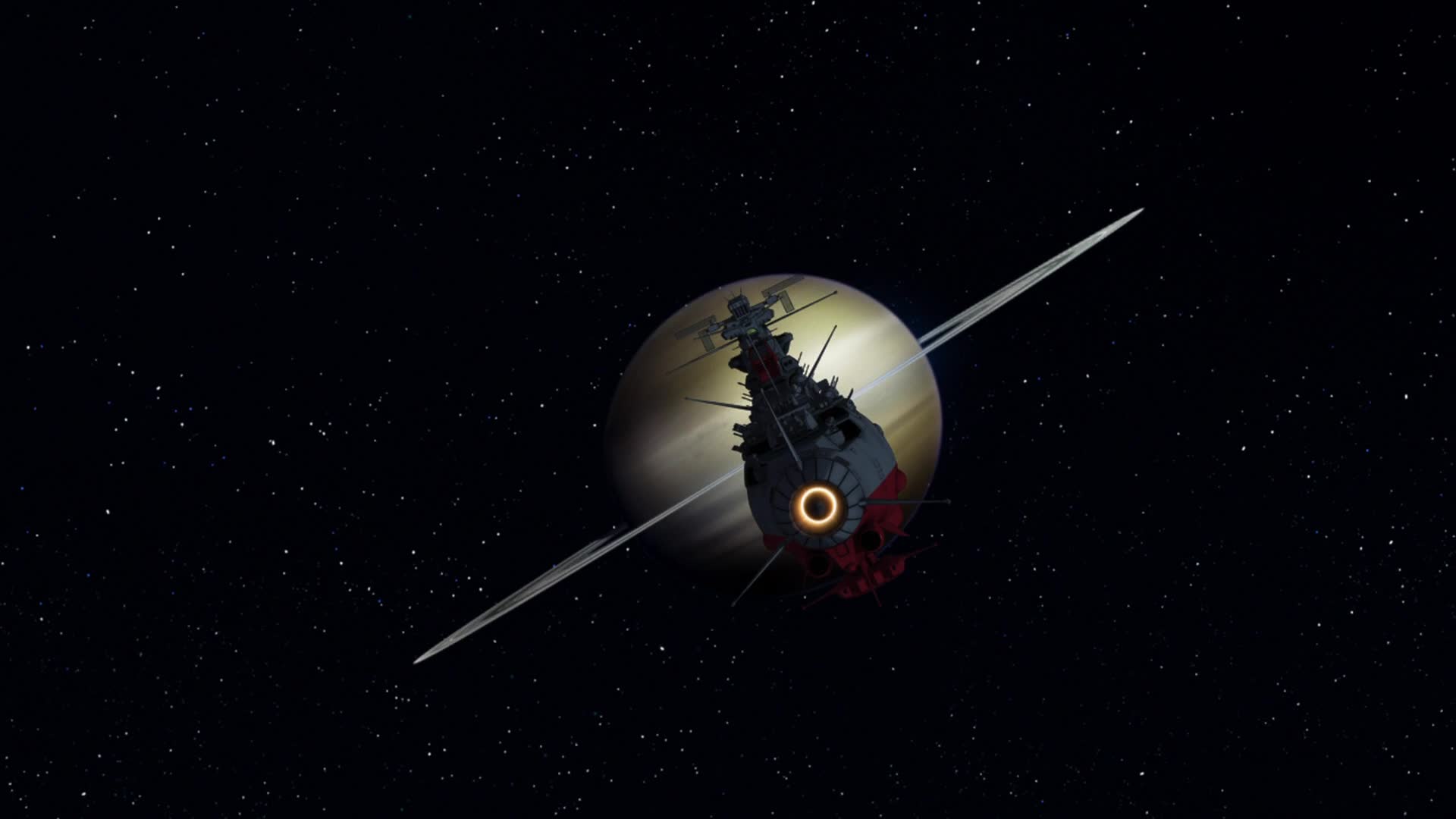
[DG]: How long did Yamato take to get from Jupiter to Saturn? If the map seen earlier in this episode is to be believed, then it has to travel to the other side of the sun from where they are, a distance approaching 15 AU, or approximately 2.25 billion km. If we assume the average cruising speed of 0.017c (18,360,000 km/h) Yamato took between Earth and Mars, it would take 122 hours, or just over 5 days to get there.
It’s highly unlikely they would warp with the engine in its current condition (assuming they even could), and there’s certainly nothing in dialog to suggest they did. It’s hardly likely that Yamato’s sublight performance tops out at 0.017c, given that if the ship continues to accelerate, it will build speed until it eventually reaches just below the speed of light. It’s not unreasonable to think Yamato accelerated to much faster than its Earth-Mars cruise speed of 0.017c.
For story purposes (and taking into account the day counter in these early episodes advances only one day per episode until Episode 6), I think it’s fair to assume that the ship accelerates to a speed that would get them there in a matter of hours rather than days. An average speed of 0.125c would get them there in around 16 hours 40 minutes; a 0.25c speed would get them there in 8 hours 20 minutes.
Given that Sanada said the Enceladus trip would amount to two days being lost, I’d say he was estimating a speed of 0.125c or slightly less, plus time to conduct the search, then turn around and head back on course out of the solar system. Since the time cost of going to Saturn was estimated by Sanada before the Cosmonite 90 was needed, it could be that a decision was made off-screen to get there faster than the 8 hours and 20 minutes a 0.25c speed would require.
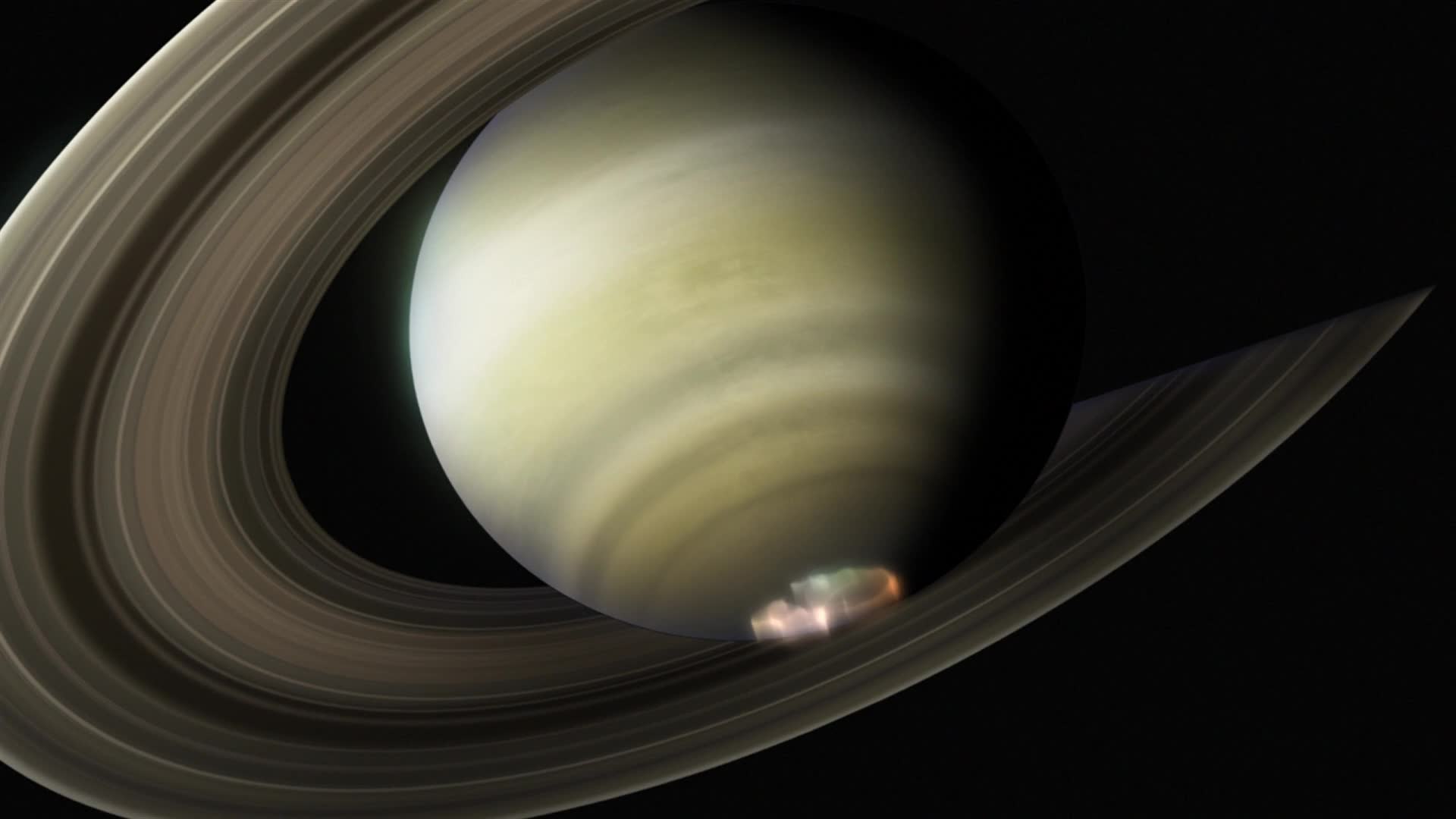

Hidden in the planet’s rings, a Garmillan transport awaits its arrival. As soon as Yamato is spotted, the troops move into action.
[LC]: The official designation for the Garmillan transport is Delamaya-class Amphibious Assault Ship and it’s a 2199 original design. It’s 92.3m long and carries a complement of 6 tanks, split between its two loading bays located in the lower bow section. The bays can be opened in flight and the tanks dropped from low altitude using detachable thruster pods which allow them to land relatively smoothly.
To make the Garmilloids different from actual Garmillans (pure-blood or otherwise), not only are they given certain inhuman motions but also you’ll notice they speak only in Garmillan.


[DG]: We see in a freeze frame here that the Delamaya is being piloted by Garmilloids. This particular example also has an entirely Garmilloid troop contingent. This is the only realistic way the Garmillans can deploy a presence to Saturn without having some sort of base facility in the area (or alternatively committing a capital ship to the area, which would be overkill).
To me, this looks like a case where Star Blazers might have given something back to Yamato: in both the original Yamato and Star Blazers, the enemy had living troops aboard the patrol ship at Saturn, but in Star Blazers, as pointed out by Arthur Painter in his commentary for Episode 6, one of the tanks was considered a “drone” so that when Wildstar was seen firing into the cockpit, he wasn’t actually appearing to kill a living being (an instance of sanitizing the show for US television). Now, Yamato 2199 has the entire Garmillas contingent at Saturn being androids, but this time for explainability and coolness factor rather than any need for self-censorship, which is thankfully no longer necessary.


Yamato descends into a ravine in the surface of Enceladus until it reaches the abandoned mine. While the mining operations are underway, Okita sends Yuki, along with nurse Harada and Analyzer, to investigate the origin of the distress signal. Much to Yuki’s displeasure, Kodai is sent along for protection detail.
[DG]: Here is a significant divergence from the original series. In the original Space Battleship Yamato, they travelled to Titan for the mineral to repair the ship, which was still called Cosmonite (but changed to Titanite in Star Blazers). In Yamato 2199, they travel to Enceladus instead. Enceladus is much closer to Saturn than Titan is, which allows the spectacular backdrop we see throughout this episode. Titan, the only moon in the solar system to have an atmosphere, is considerably further away, and even if it were closer to Saturn than it is, nothing would be visible because of its opaque atmosphere.
[LC]: During production of the episode, the rocket anchor was meant to be used in this scene. But because it had already been seen in the previous episode, they left the job of maintaining Yamato‘s position to its gravity control system.


At the mine, chief Enomoto jokes with Sanada about Kodai’s mission, since he seems totally inept at dealing with women, which Enomoto learned at training school as one of Kodai’s instructors.
[LC]: When we meet chief Enomoto at the Cosmonite 90 mine, he is humming The Galactic Pilot, the anthem of the UNCF heard in Episode 1 during the sinking of Yukikaze. A bit of foreshadowing?!
[DG]: Here, Enomoto mentions that Kodai is “escorting the Princess,” another one of those little bombs in the ongoing uncertainty about Yuki’s identity.


Aboard the Cosmo Seagull, Makoto observes the two officers as Kodai attempts to start a conversation with an uncooperative Yuki, even asking if she has any aliens in the family, an allusion to her resemblance to Sasha.


Faceplant and hilarity ensues. Analyzer cuts the conversation short as he signals they’re overflying the point of origin of the distress signal, a UNCN destroyer covered in ice and snow.
[DG]: An interesting thing to note here is that three of the characters who flew this mission in the original (Yuki, Kodai, and Analyzer) are on the mission again, along with Makoto Harada who has taken over Yuki’s role (one of many) in the original series as nurse. Unlike the original series, which was flown in a Type-100-style plane, Analyzer is kept a safe distance from Yuki. Not that he’s getting up to those sorts of shenanigans this time around.
Another thing I find refreshing is that at this stage in the series there is a large degree of animosity between Yuki and Kodai. Their bickering is priceless, as is Makoto’s interpretation and Analyzer’s deadpan response. Kodai’s question to Yuki is also priceless, as are the look on Yuki’s face and Makoto’s faceplant – quite a feat in the low gravity that Enceladus would have in reality (more on that later).


[DG]: Unlike in the original series, where the Type-100 was used, a new aerospacecraft, the SC-97 Seagull, is introduced for the first time. With its listed length of 19.5 meters, it is comparable to carrier-based aircraft such as the Lockeed S-3 Viking anti-submarine warfare aircraft, and has a very similar cockpit design.
The similarities end there though, as the Seagull has gull wings which rotate 90 degrees. This allows VTOL operation by tilting its underwing engines to a vertical position, a common trait of 1970s experimental VTOL aircraft, one of which eventually evolved into the V-22 Osprey, which also has a similar cockpit to the Seagull. There is a large cargo section (which looks detachable or modular in design) and twin-tail booms to allow cargo access. It certainly looks more fit than the Type-100 would be in this case.


The Delamaya transport approaches Enceladus, and once at the proper altitude, unloads a complement of tanks which proceed to the crash site while the ship heads for Yamato. The medical team makes their way to the downed ship, which Kodai quickly identifies as an Isokaze-class assault destroyer, the same as his brother’s Yukikaze.
The hull is covered in ice and they can’t see the ship’s markings to positively identify her. Makoto calls out to them, having found an open hatch. Once inside, they discover one of the crewmen, frozen to death.
[LC]: Instead of using CG, the crashed Yukikaze was hand-drawn by Masanoru Nishii and enhanced with digital effects to give it its frozen look. Mr. Nishii made his drawings with the usual level of super-detail we’ve become accustomed to by now, even though he knew most of the detailing would probably be lost under the layers of ice. But he felt it was important to have the detail there just the same, as it shines through the finished product. In his opinion, this was one of the hardest things to do in Episode 4. Click on the frame above left to see his layout for the scene.


On the bridge, they discover the automated distress signal is the only system still functioning. While Kodai is looking for the ship’s log, a bolt of light goes by the window and the ship is rattled by an explosion. Kodai looks out the window and sees the Seagull has been destroyed by approaching Garmillan tanks.


While Yuki attempts to get a radio working and call Yamato for help, the ship takes two hits and Makoto finds herself trapped with Analyzer. Kodai tries to open the hatch, but the handle won’t budge. He tells Analyzer to start proving the skills he so proudly spoke of earlier. Yuki gets through to Yamato only to learn that they’re also under attack.

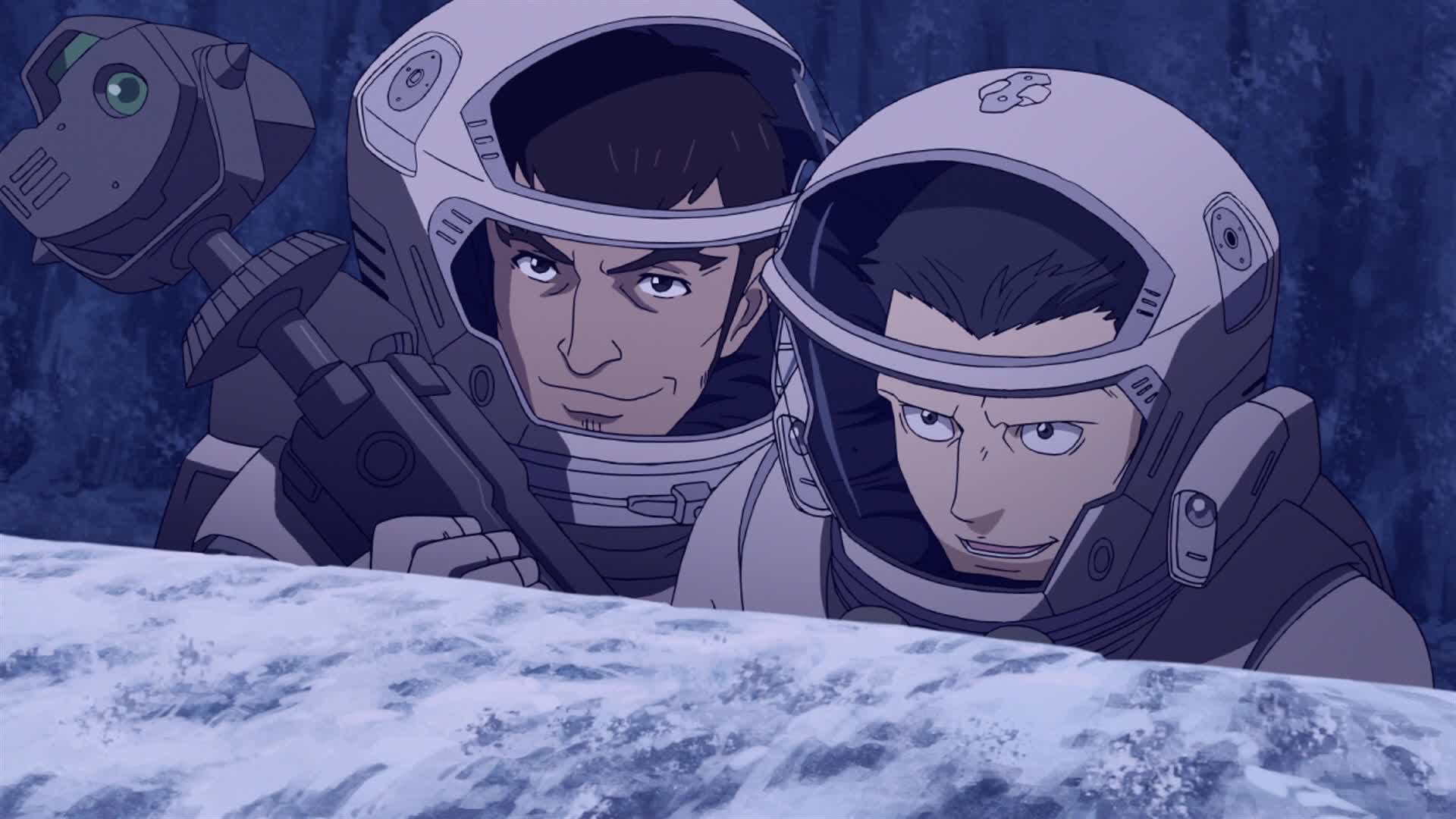
With the main engine offline, there is no power for the main weapons, so the air wing is ordered to scramble. Kato’s men run to their fighters, passing a pensive Yamamoto. As the tanks open fire on the mine, Enomoto has his men withdraw and finds shelter in a trench along with Sanada, who insists the enemy forces are not enough to take down Yamato.


Back at the crash site, Analyzer is using his plasma cutter to free himself and Makoto. Kodai is impressed, but suddenly notices the silence around them. The tanks seem to have suspended their attack. Yuki warns him of Yamato’s current situation. In the main hangar, Kato and his squadron are having problems.


With the ship so low, the Falcon’s launch system can’t be used, at least until they recover the mining team and gain altitude. With no other choices, Kato decides to “borrow it,” meaning Kodai’s Cosmo Zero.
[LC]: This is the first time since Episode 2 that we see the Cosmo Falcon’s hangar bay door open. Due to this logistic problem we won’t get to see it put to use…yet. Also, we see bridge number 3 being used once again as the entrance to the ship.


In the Zero’s hangar, a pilot gets into Alpha 2, the second Cosmo Zero. When Kato and Shinohara arrive to man the two fighters, the ground crews are confused. If the pilot isn’t one of Kato’s men, then who…?! Before any questions can be asked, Alpha 2 launches from Yamato’s starboard aft catapult.
[LC]: The least mysterious mystery pilot ever, as we all know who it is. A question does pop up in my mind: where did Akira get that flight suit? The simplest answer is that she kept the hope of becoming a pilot and just had one made. One of the perks of working in the logistics division.


[LC]: A more important question is that of the apparent lack of security aboard Yamato, an irony given this is the first time Yamato has an actual security department. But Akira gets on a fighter without authorization and is free to leave with it, and this won’t be the last time. But that’s a subject for a future episode.
Though the Zero launch sequence is basically the same as in the original, in 2199 the level of detail is through the roof. From the Zero unfolding to the elevator platform and the catapult opening up to receive the craft, every step is shown intricately.


A tank closes in on Sanada’s position, destroying one of the laser cutters which the sailors tried to use as a makeshift weapon. Alpha 2 shoots the tanks before they can do any more damage, and is then fired on by the AA weapon from the APC. Kato arrives in Alpha 1 and destroys the APC before demanding the mystery pilot to identify.
[LC]: Two types of tank are deployed at Enceladus. The Salvah S-VI Heavy Tank is the main attack force, with its triple barreled turret. The Melbah M-III Armored Personnel Carrier is used to transport the Garmilloids and serve as support. Its laser turret provides rapid fire and poses a serious threat to airborne attacks.
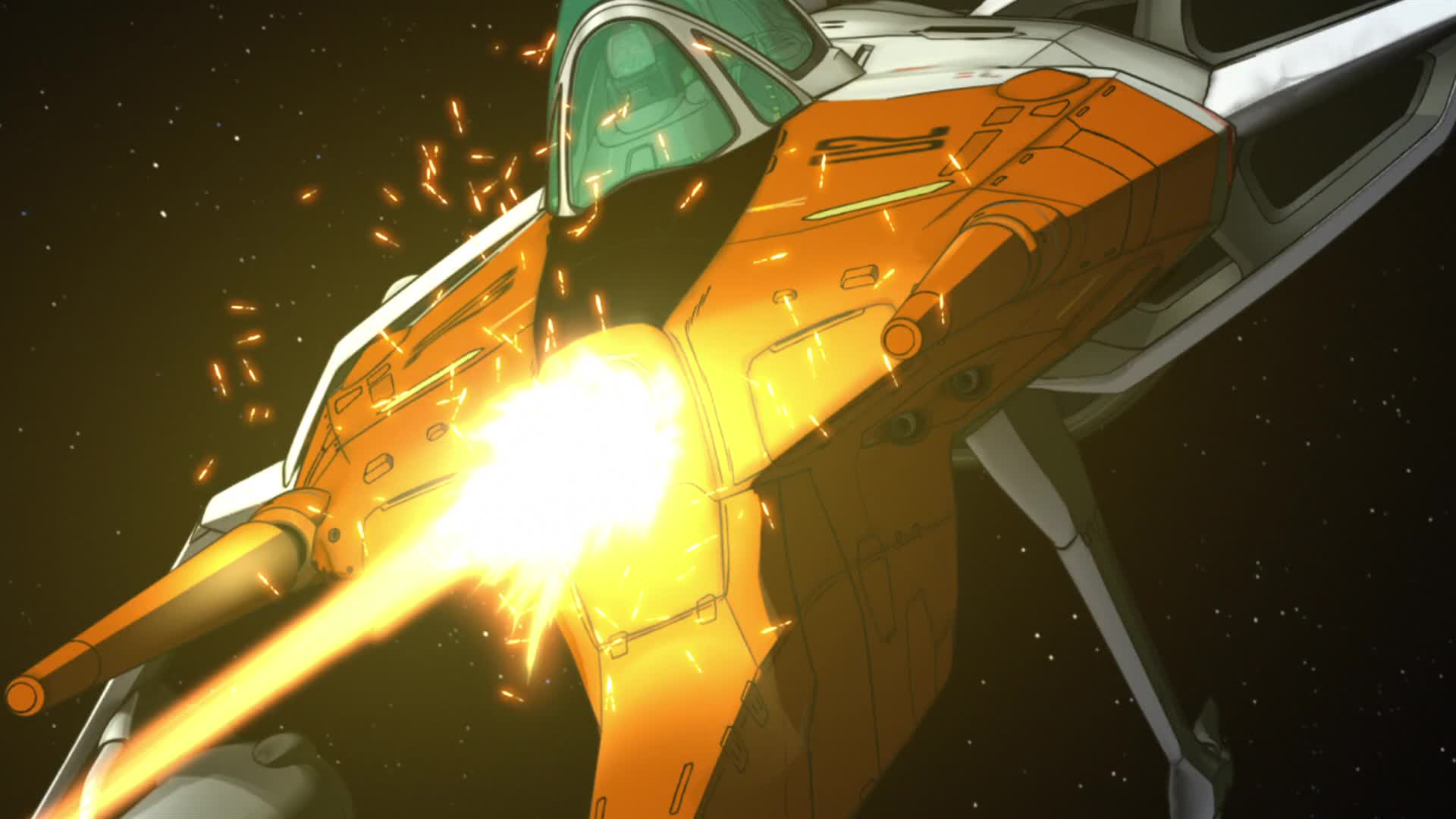

[DG]: Here we see the first of the Zero’s weapons in action. While we saw in Episode 1 that it retains the four cannons under the nose, though they are now ballistic (slug-throwing) cannons/machine guns, the star of this episode is its huge centerline anti-tank cannon. While there is no official listing for either of the Zero’s cannon types, according to the model kit and design drawings the width of the cannon’s muzzle is about 108mm. Allowing for the actual gun inside to be marginally smaller than that, we’d reach 105mm very easily, which in the present day is a standard light artillery round caliber.


The conversation is cut short by shots fired from the Delamaya. Even not knowing who the pilot is, Kato has no option but to send Alpha 2 to rescue the medical team while he deals with the enemy transport.
[LC]: Even though he doesn’t say so, I’m pretty sure Kato knows who the pilot is. Why else would he entrust such an important mission to someone who just stole one of his fighters?


On the wreck’s bridge, Yuki is still at the comm station, unaware of a shadow looming outside the windows. Alpha 2’s pilot calls in and tells her help is on the way, just as Yuki feels prying eyes watching her.
[LC]: If there was still anyone who had doubts about the identity of Alpha 2’s pilot, hearing Akira’s voice on the comm system should clear it right up.
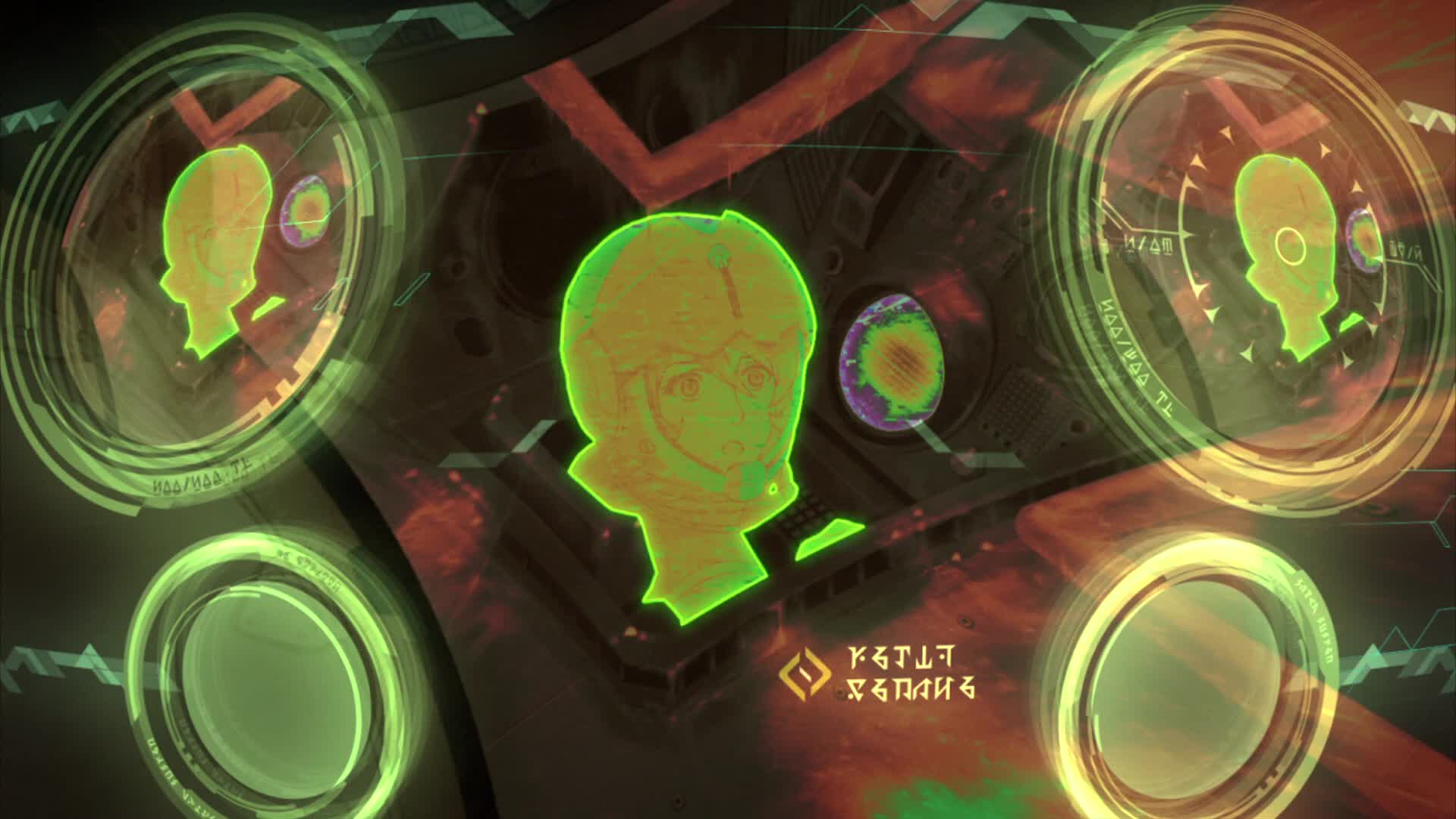

As Analyzer finally gets the hatch open, a scream echoes from above. Kodai runs up the stairs to see two enemy soldiers, one carrying a seemingly unconscious Yuki.
[LC]: In the manga version, Yuki’s run-in with the Garmilloids is a bit more humorous. As she turns around, she finds herself face-to-face with a Garmilloid, hanging upside down from the window above. Her expression is priceless.
The Garmillan sentence spoken by the Garmilloid in this scene is “tsubak kan salma,” which translates as “take her to the tank.” This is the sentence that served as a base to build the Garmillan language structure.


The other one opens fire, forcing Kodai to step down to the hatch. A stray shot blasts his gun out of his hand. While Analyzer shields Makoto, Kodai notices a metallic gleam on the icy ground. One of the shots broke the ice, revealing a fallen sidearm. Kodai jumps at the chance and grabs the weapon, shooting the enemy soldier that comes crashing down the stairs.


As Kodai gives chase to the other one, Makoto asks Analyzer for the medical kit, since she will help anyone wounded, friend and foe alike. But to her surprise, as she turns over the soldier, she realizes it’s a robot.


While Kato dodges enemy missiles and manages to shoot down the Delamaya, Kodai runs after the enemy soldiers. Under heavy fire, he manages to shoot one of them. As the second soldier takes aim, one of Enceladus’ ice geysers erupts, causing the APC to be destroyed and leaving the soldier stranded.
Enceladus “geysers” are actually cryovolcanoes, where water and other volatiles are the erupting materials instead of silicate rock. These spectacular features are mostly concentrated on the south polar region in a feature named the tiger stripes of Enceladus. Over 100 of these geysers have been identified, and the jets can reach over 700 km in altitude.


Kodai tries to get a clear shot, but is afraid to hit Yuki. As she regains consciousness, she strikes the enemy soldier and causes him to drop her. He holds up his sidearm menacingly, but he’s shot by Kodai before he can fire.
[DG]: This is probably the best example of how the animators seemed to have assumed Earth-level gravity for the sake of the story. In reality, Enceladus has 1.13% of Earth’s gravity. Had that actually been held to in this episode, we would have seen people floating all around the place rather than diving for cover.
[LC]: The manga does tackle that question by making use of the space suit thruster packs. For example, in this scene where Yuki kicks the Garmilloid, she fires the thrusters to help her move. Another detail is that the tanks don’t jettison their thrusters, but use them to anchor themselves when they fire their guns.


Yuki gets up to thank Kodai, only to see him running toward her. He shoves her to the ground as they come under fire from the last tank. As the tank makes its approach, Kodai spots the incoming Zero and has Yuki duck for cover as the fighter takes its shot and destroys the tank. As it rises back into the skies to return home, Kodai and Yuki are impressed by the pilot’s skill.
[LC]: Another manga highlight is the more complex maneuver Akira makes to get the last tank in her sights.


As she notices how close they’re holding each other, Yuki snaps to attention, issuing an embarrassed thank-you to her savior. Kodai, oblivious to her embarrassment, states that they owe their safety to the sidearm he found. Suddenly, his expression goes blank. After a moment of pause, he runs off toward the wrecked destroyer, leaving Yuki confused as the ice from the geyser begins to rain down on them.
[LC]: Time for the reveal we knew was coming. First, if you look at the starboard side of the ship as Kodai runs toward it, you’ll see its ID number: 117.


As he reaches the ship, Kodai takes aim and fires several shots at the ice covering its hull, causing it to fall off. Kodai is stunned. He falls to his knees as Yuki approaches. Looking down at the weapon he holds, she sees an inscription on the grip. “Mamoru Kodai.” Yuki looks at the hull markings which were hidden by the ice wall and realizes this destroyer is none other than Yukikaze herself, Mamoru’s ship.
[LC]: People will probably ask “Hey, how can Yukikaze have crashed on Enceladus if it exploded in episode 1?” Well, explosions in most media – not just anime – are mostly about spectacle value or to visually enforce the violence of the event that causes them, not an accurate depiction of the damage incurred.
In the case of Yukikaze, the huge explosion we saw wasn’t the ship being blown to millions of tiny pieces. She did sustain heavy damage, as we can clearly see from the huge gaping hole in its port side, but the blast we saw was the port drop tank exploding. Careful observation of the crashed ship will reveal that it is gone. As to how Yukikaze managed to travel all the way to Enceladus in such a crippled state…well, back to suspension of disbelief, I guess.
I’ll just add this: remember when they arrived at the ship and Makoto found that open hatch? I wonder if it opened in the crash or…


[DG]: Yukikaze’s ship number, 117, is visible on the starboard side, which made me wonder why Kodai didn’t notice it before. It would be reasonable for him to know the number of his brother’s ship as well as its name. Upon rewatching, I figured out why. When they land the Seagull near the wreck, it’s on the port side, which has a blast hole right where the number would be, and thus Kodai doesn’t see it. After seeing Mamoru’s name on the pistol, he was too focused on shooting her name away to see the number plain as day on the starboard bow.
An oddity here, which we first saw back in Episode 1: while all official materials list ship names in katakana (to keep consistency with Yamato‘s ヤマト), the Operation M ships all have their names stenciled in hiragana instead. (for the record, the Imperial Japanese Navy battleship Yamato had its name rendered in kanji – 大和).
[LC]: The use of hiragana is consistent on hull markings; even Yamato has its name written in hiragana on the hull, though Yamato’s marking is a lot more subtle. How subtle? Well, some of you are probably thinking “what markings?!”, that’s how subtle they are. If you don’t know where they are, stay tuned for episode 5.


Later, Yamato hovers over the crash site. In the port observation deck, Sanada looks at Yukikaze and salutes her while Niimi observes silently.
[LC]: While here they kept Niimi’s reaction quite subtle, not wanting to give too much away this early in the story, the manga chapter was published after Niimi’s past relationship to Mamoru and Sanada had been fully disclosed in the anime. Thus, her reaction is a lot closer to what we got to see in episode 24. A tearful moment.


In the Zero’s hangar, Kato and Shinohara are awaiting the mysterious pilot. The helmet comes off, revealing Yamamoto to a less-than-surprised and visibly-annoyed Kato.
[LC]: Oh! Surprise, surprise. For Shinohara, at least. If the previous scenes and her talking on the radio hadn’t been enough, the fact that we clearly see the mystery pilot is a woman should have given it away before she took her helmet off.


Yuki returns to the bridge and asks where Kodai is off to. Shima tells her he’s debriefing the captain. She looks at Kodai’s empty chair, where the holster holding Mamoru’s gun lies. In the captain’s cabin, Kodai reports that the ship they found was Yukikaze and that they found no survivors. A visibly saddened Okita tells Kodai that they won’t allow the same fate to befall Earth.


Yamato fires its main engine and leaves Enceladus, Kodai and Okita saluting Yukikaze as they leave. Alone in the icy field, the defeated destroyer is now flanked by a makeshift gravestone. It reads “here lie the twenty-four brave souls who crewed Yukikaze. May they rest in peace.”


PREVIEW:
The planet with the king of the dead’s name stands before Yamato. Unless the planet is overcome, humanity has no future. All crew, battle stations! Our target is Pluto! Can Yamato break through the trap that lies in wait? The biggest battle of the solar system begins now.
Next time: The Trap on All Sides.
There are 362 days left before humanity becomes extinct.

RELATED LINKS:
Official website of Yamato 2199
Yamato Crew website
Chapter 2 Trailer
Episode 4 credits
Screenplay: Hiroshi Onoki
Storyboard: Yutaka Izubuchi
Director: Masato Bessho
Chara Animation Director: Keizo Shimizu, Akihisa Maeda, Nobuteru Yuuki
Mecha Chief Animation Director: Masanori Nishii
Series credits
Original Story: Yoshinobu Nishizaki
Planning: Shoji Nishizaki, Mitsuhisa Ishikawa, Satoshi Kono
Original Character Design: Nobuteru Yuuki
Guest Character/Prop Design: Shinichi Yamaoka
Mecha Design: Junichiro Tamamori, Yasushi Ishizu, Kiminori Yamane, Yutaka Izubuchi
Set Design: Takeshi Takakura, Makoto Kobayashi, Takashi Watanabe
Concept Design Support: Kazutaka Miyatake
Chief Director: Akihiro Enomoto
Director of Photography: Takashi Aoki
Art Director: Minoru Maeda
Video Editing: Emi Onodera
Color Correction: Rumiko Suzushiro
Music: Akira Miyagawa, Hiroshi Miyagawa
Sound Director: Tomohiro Yoshida
Sound Effects: Mitsuru Kashiwabara
Chief Mecha Animation Director: Masanori Nishii
CG Director: Takashi Imanishi
General Director: Yutaka Izubuchi
Production: Space Battleship Yamato Production Committee
Production IG, Bandai Visual, Xebec, Bandai, Bandai Namco Games, Voyager Entertainment,
Tohoku Shinsha Film Corporation, Shochiku Co. Ltd., OLM, Lantis Co. Ltd.
CG Production Support: Sunrise D.I.D.

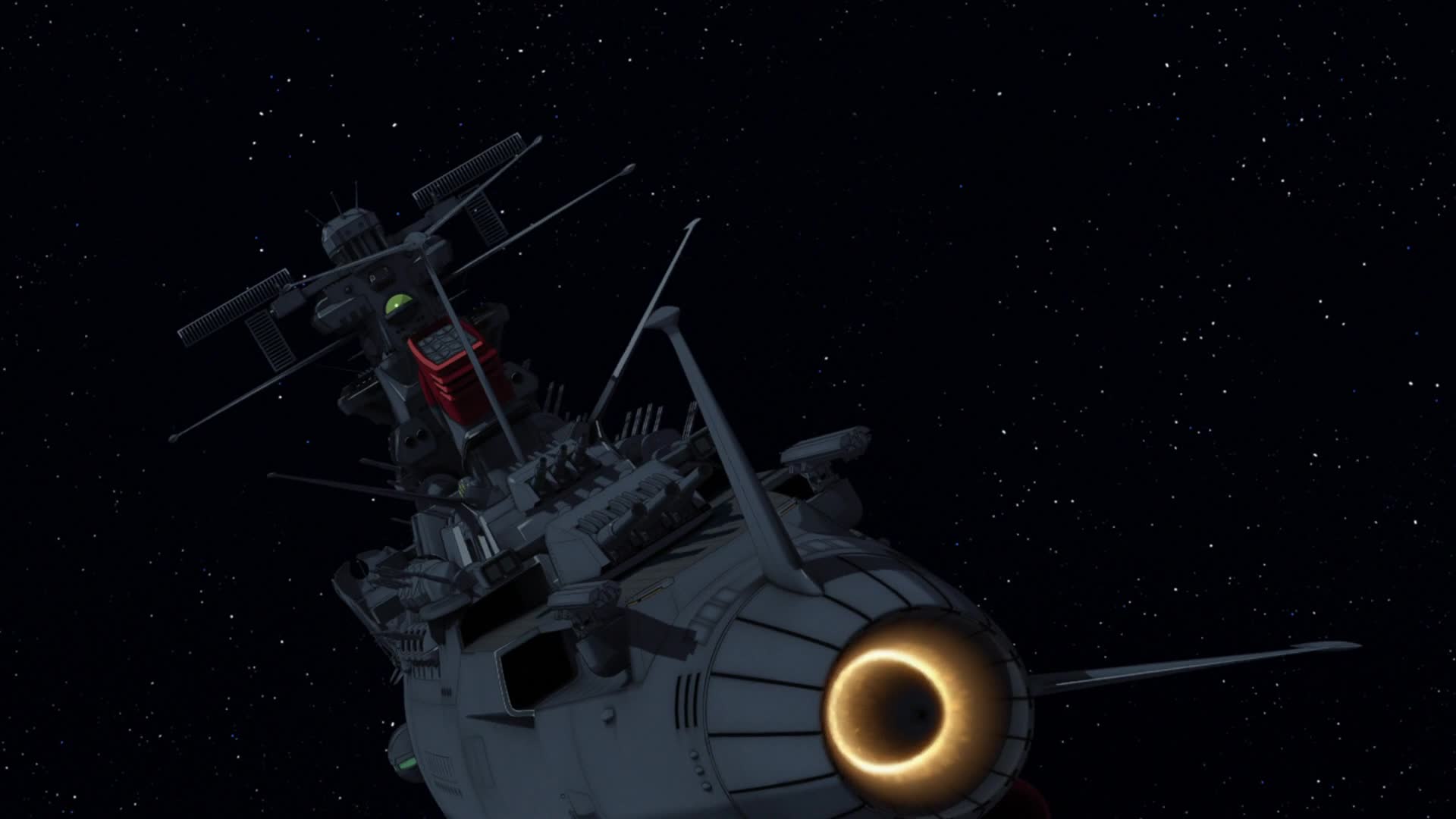

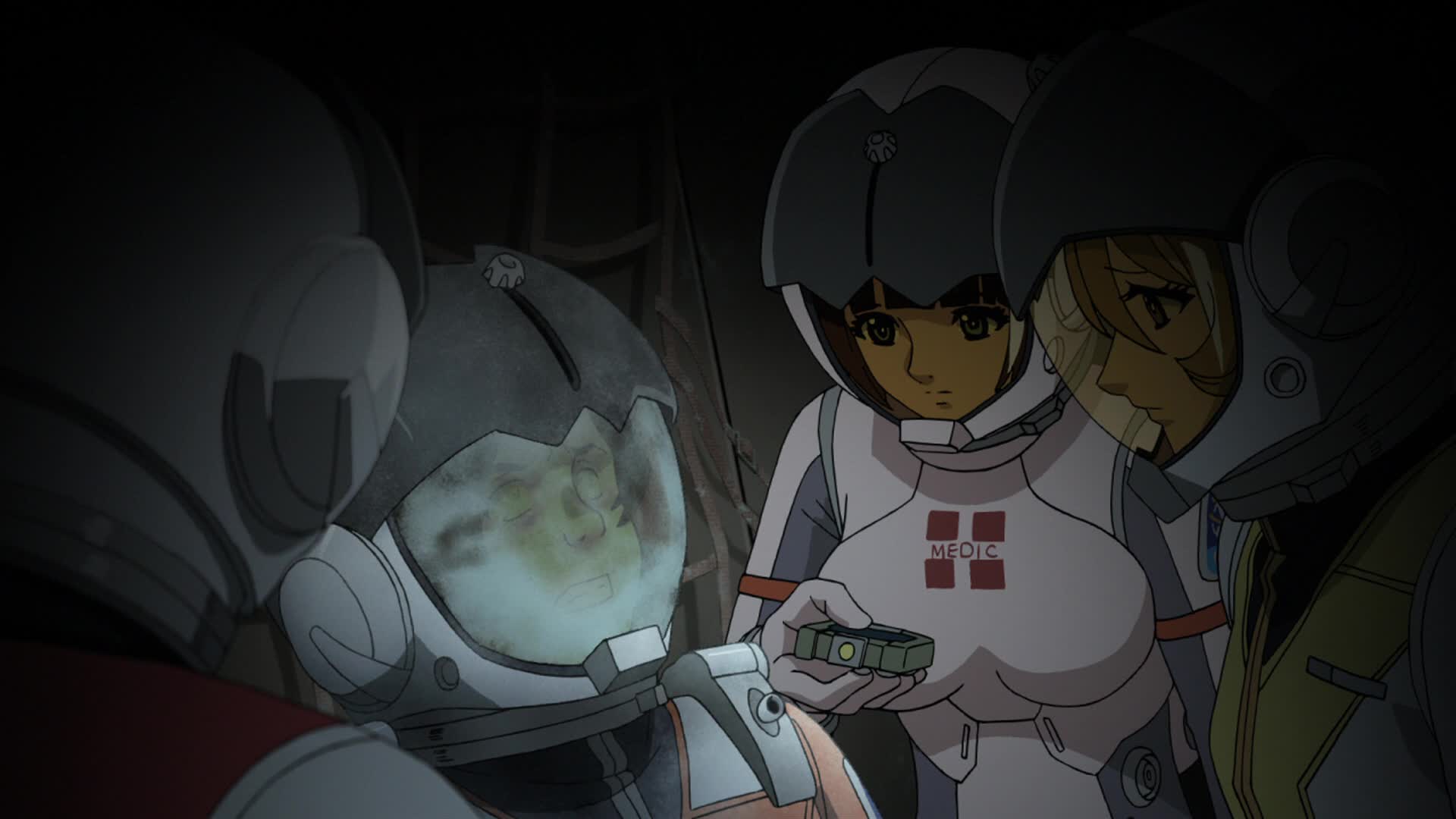
I just wanted to leave a note to let you know that these commentaries are fantastic. Almost as much fun as watching the episodes themselves. Please keep up the great work, I really appreciate having great analysis and reactions like this available, and I know I’m not alone in that. Thank you for putting these together.
Thanks Eric! Much appreciated to get feedback. Both Luis and I appreciate it greatly.
Interesting question: how exactly damaged “Yukikadze” was able to make way to Enceladus and crash-land here (not just crash)? From Pluto to Saturn the way is quite long, and hardly could be made just by incident. And they not only were able to fly all this distance in just a few weeks, but also able to decelerate and make crash-landing here…
P.S. Maybe they need ice? After all, their ship was damaged, probably low on oxygen, fuel and reaction mass, and Enceladus is one of the few places in Solar System, where the water ice is avaliabe in large quantites.
It’s called plot overriding the laws of physics. The director has said they’ve changed the physics except where it affects the telling of the story. Original 1974 story had Yukikaze crashed on one of Saturn’s moons. Physically improbable, but it’s one of the critical story points, so it stays. End of story. No further discussion on the physics behind it is needed, nor will be entered into.
The OMCS manages all consumables on board. Recycles water, air, waste materials, etc. The only thing they needed on Enceladus was the mineral to repair the wave-motion engine.
The wave-motion engine defies all laws of physics. It takes its energy from the wave-motion energy surrounding it (i.e. no fuel – the wave-motion engine’s only “fuel tank” is the wave-motion generation chamber where the wave-core is installed), and requires no reaction mass to turn this into motive thrust.
Rule One of anime: Real-world physics do not apply in anime, except when they can work it into the story.
Well, we could actually make a wave-motion engine a bit harder 🙂 We could assume that the engine uses vacuum fluctuation to produce exotic matter in terms of long-existing virtual particles and then accelerate them as exaust/weapon discharge.
Actually, the engine/weapon unity was always the pretty hardest part of “Yamato”; basically ANY powerfull enough rocket engine could be quite easily converted into powerful particle cannon by just providing focusing at the exaust.
“The OMCS manages all consumables on board. Recycles water, air, waste materials, etc. The only thing they needed on Enceladus was the mineral to repair the wave-motion engine. ”
The “Yamato” could – but she was designed as autonomous unit.
I really doubt that in-system destroyer – damaged destoyer – have the same level of autonomy.